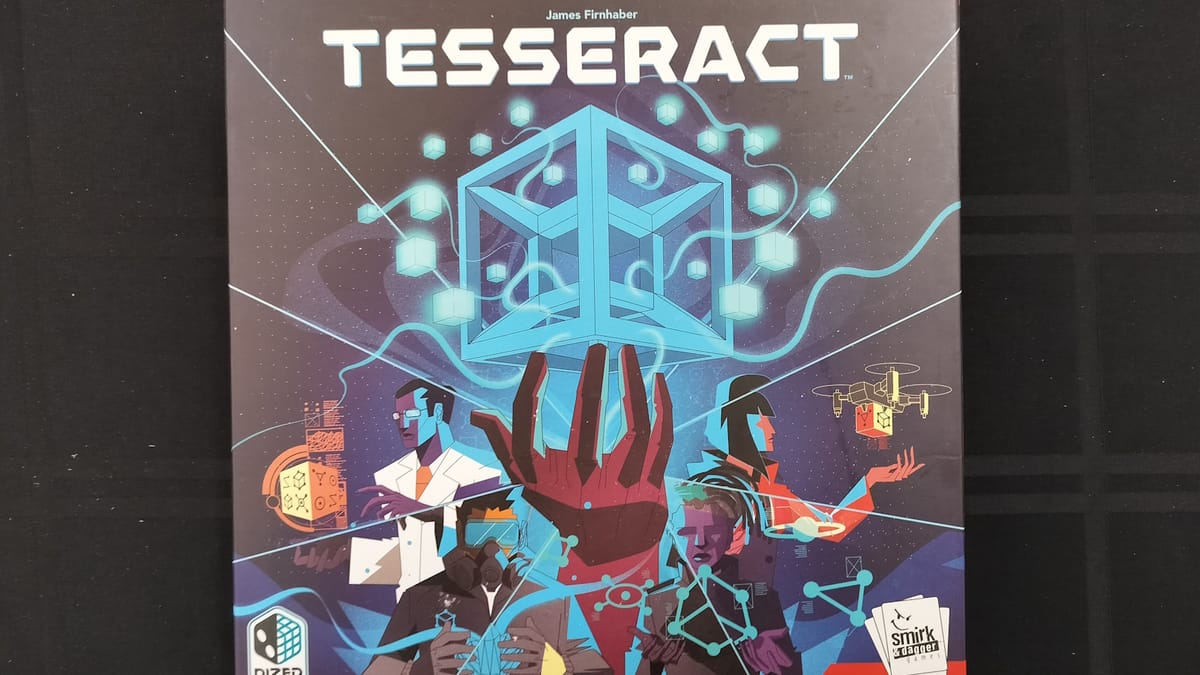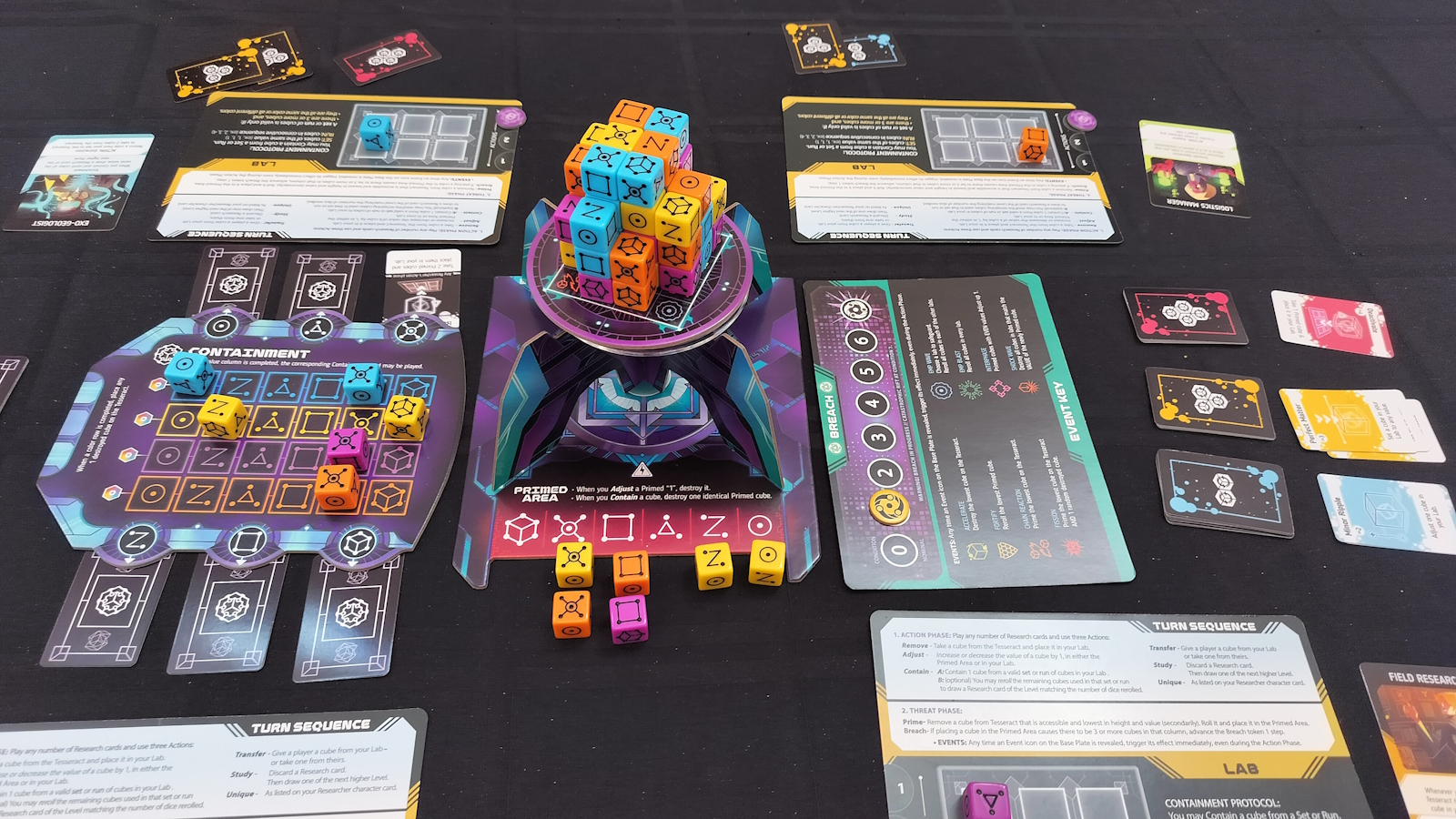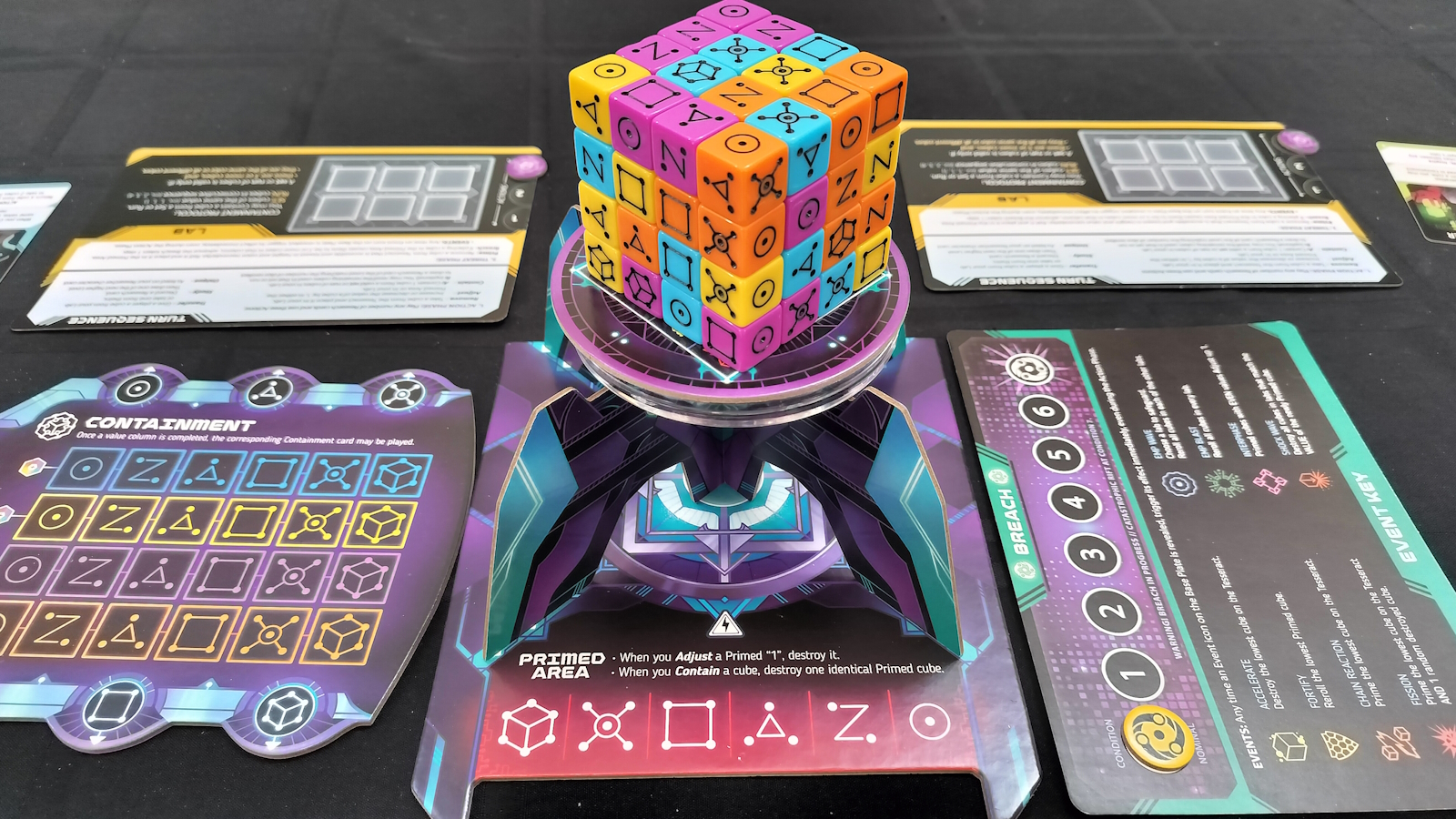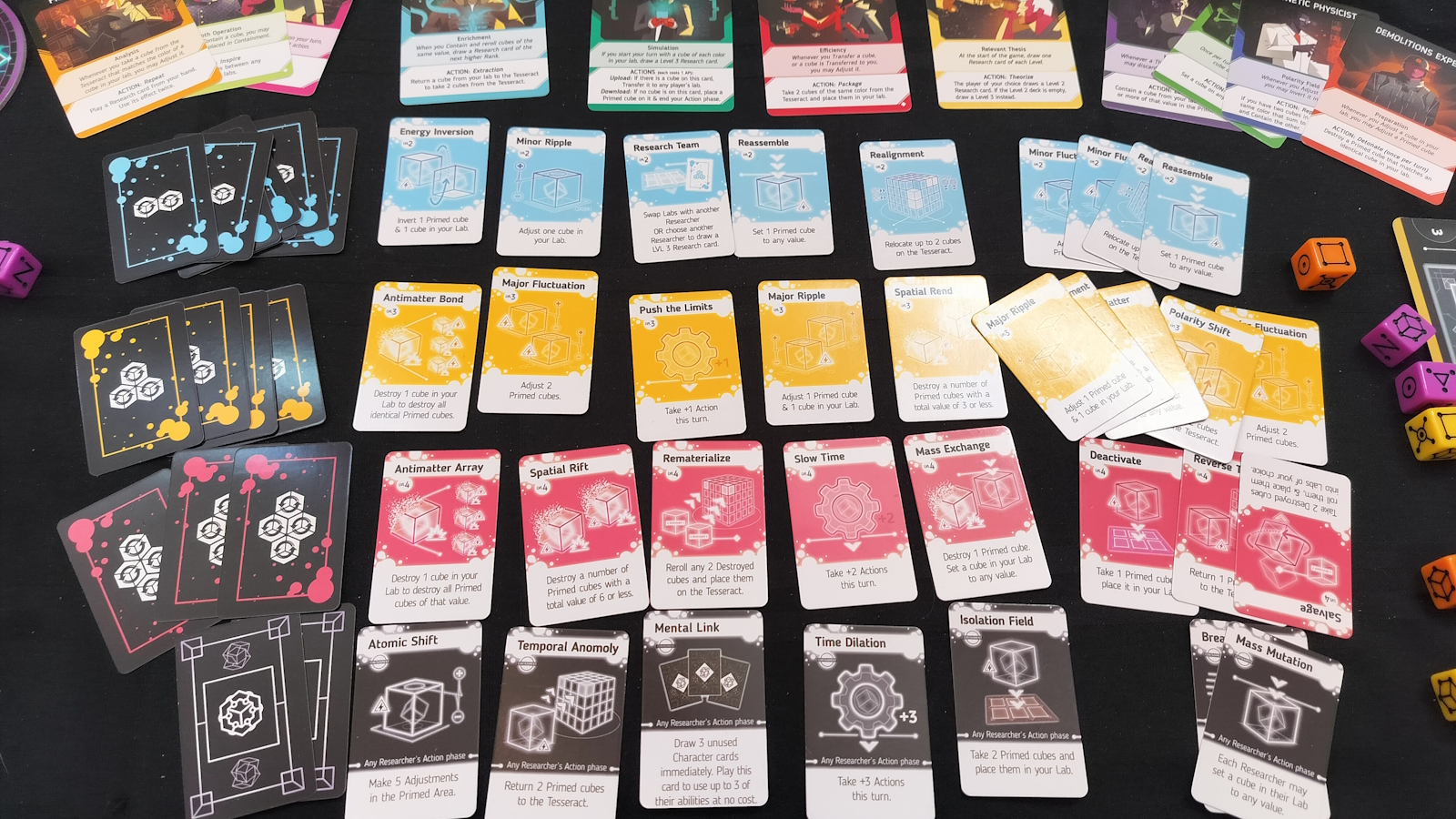
Something not of this world arrived. Initially, it was the size of a city, but it quickly shrank, and shrank, and shrank, until it was no more than a small cube with cryptic symbols floating in space. Scientists the world over gathered to study it, but soon realized that there was an immense, and dangerous power inside that cube. The Tesseract, if not handled properly, would explode. Worse, it’s unstable, and will detonate even if left alone. In Tesseract, you play one of these scientists, tasked with decoding and disarming this multidimensional Bomb.
Tesseract is a cooperative puzzle game for 1-4 players designed by James Firnhaber and published by Smirk and Dagger. Each player will take on the role of a unique scientist to manipulate a cube of dice in order to completely disarm it before the cube empties or it becomes unstable and the whole thing blows up.
The titular tesseract is made up of a 4 x 4 x 4 cube of multicolored dice. These 64 dice come in 4 different colors, and range from 1-6. Count the corners and ends of the lines on the faces, these are the pips. The lines are just for show, to make them look like alien symbols.

Each turn, a player has 3 actions to manipulate the dice on the tesseract. They can take one die to their board, but only if the die has 3 exposed faces. They can also manipulate dice on their own board, pushing a die one pip in value up or down. These moves are there to help set up for the most important action: Containment. When a player has either 3 or more dice of the same value, or in a run, and those dice are of the same color, or a different color each, then they can contain them. This puts one of those dice on the scoreboard, which brings the group one step closer to winning. It also clears any dice out of the breach zone that perfectly matches the contained die. Finally, it earns a powerful research card, based on the size of the set or run used.
Research cards are critical to success. They provide free actions, and these actions are often outside the scope of what you’ll normally be able to do with your turn. There are 3 levels of research cards, and each one represents a stronger action to be able to take with it. Examples might include taking breached dice and putting them back on the cube, changing dice pips to whatever you want, or preventing a breach from happening. Players can choose to discard a card as an action, which allows them to upgrade their card to the next level.

Of course, the cube isn’t just letting these things happen to it without issue. The tesseract is coming apart of its own accord. After each player’s turn, the lowest available die gets removed and rolled randomly. This random roll then gets put on the breach board. If 3 or more dice of the same value are on the breach board, the tesseract moves one step closer to going critical. If there’s 6 dice of the same value, it moves two steps! The players can use their pip-manipulation ability on the breach board dice as well, however, so they can move some dice around to prevent too many from stacking up. It may even be beneficial to stack more in one location to reduce the chances of a breach! It’s also possible to reduce a breach die below 1, removing it from the board entirely.
Worse, anytime the last die is removed from a chunk of the tesseract, it reacts with a powerful effect. This could chain react into several game ending effects, and is the primary difficulty adjustment for the game. The lower difficulty effects are simple, like removing a die from the game or moving dice around on the tesseract. The higher difficulties, might draw more dice from the tesseract at once, potentially cascading into removing 4 or 6 dice from the tesseract at once, or causing multiple breaches in a single turn.
As the players progress through the game, they will also unlock powerful, one time effects from the containment board. These can be life-saving, offering chances to bring the game board back to a relatively controlled state from freefall.

Finally, each scientist has some special abilities. These range from swapping dice with allies to getting research cards on the cheap. These abilities become critical as the game goes on, since these unique abilities can provide tools for solving the evolving puzzle that can keep the game going till the end, instead of ending in a tragic explosion.
Overall, it’s not a bad puzzle experience. I enjoyed the games I’ve played of Tesseract, both with multiple players and alone. However, it can’t help but suffer from the same problems that other cooperative games suffer. The first of these sins is the problem of quarterbacking (or captaining). Basically, one person who groks the puzzle (or thinks they do) tells all the other players how best to take their turn. This is even harder to fight against as the best play is often straightforward. I feel this is worse than even in games infamous for quarterbacking like pandemic because there are even fewer variables to consider in solving the puzzle.
The second problem it suffers from is difficulty. I think I only failed to achieve victory once in my plays of Tesseract. Even on the highest difficulty level, it’s not an overwhelming challenge. Several games did come close, down to 1-in-6 die rolls or a last second clever play, but overall it doesn’t seem to bear the same challenge as some of Tesseract’s contemporaries. Still, for players looking for a challenge that is very much beatable, Tesseract might be for you.

Overall, the greatest draw to Tesseract is the tactile challenge of beating the cube. There is an amazing table presence, each player staring down this alien thing on their table. The game comes with a lazy susan to make rotating the cube a breeze as well, so each player can see all sides of the cube without worry. The rules are also explicit: This isn’t a dexterity game. Don’t sweat accidentally knocking a die off when you didn’t mean to, just put it back as best you can. Explicitly calling out these kinds of things helps make the game be more welcoming to players, instead of punishing them for mistakes.
The setup and teardown of Tesseract is quite easy as well. Once might suspect that a game with 64 dice stacked neatly in a cube would have a rough set up, but the included dice bag for randomization, and the cardboard sleeve that makes a perfect cube every time makes setup super easy. Teardown is just as easy, just dump all the dice back into the dice bag, and clean up the cards as normal.
If you’re looking for a cooperative game with a more tactile feel, then Tesseract is great, as long as you’re also not looking for a great challenge. This means it might be great for younger players, or those who are newer to gaming. Certainly, bringing out a cube of dice might be exactly the hook someone needs to get them started on cooperative games overall.
Tesseract
Good
A game with an eye popping table presence and solid mechanics. However, the game doesn’t offer enough of a challenge to play forever.
Pros
- Incredible table presence
- Easy set up
- Solid puzzle mechanics
- Tactile gameplay
Cons
- Sometimes retrieving dice can be a bit fiddly, but the rules are forgiving.
- The game does not scale in difficulty to a challenge worthy of long time players.
- Does not do anything to prevent one player from solving the game for everyone else.
